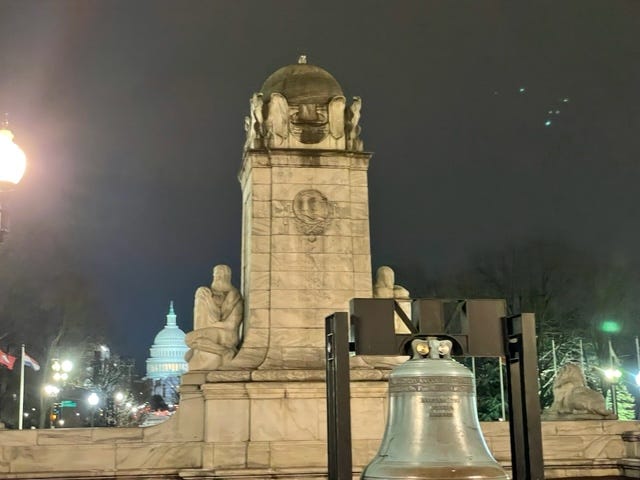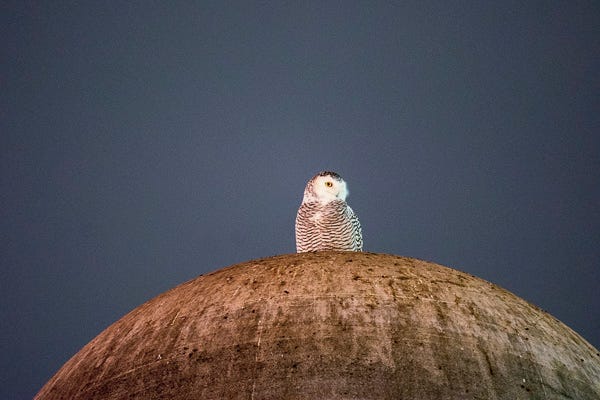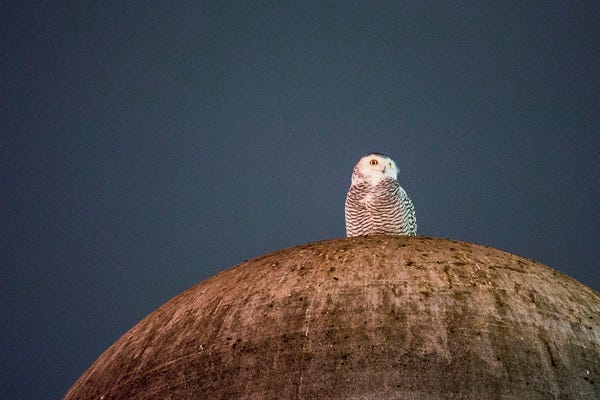The Snowy Owl at Union Station
Because of course it showed up there, after I was almost locked all night on the beach on Long Island
Here are some of the things I crave right now, in the middle of January, in the middle of a pandemic, after being inside a 600 square foot apartment with one cat, sick, for 10 days:
I crave loud colors. I crave the unexpected. I’d like to wear weird, clashing colors and I’d like to be around other people also wearing weird clashing colors — maybe on a train platform or waiting for a band to perform — and I’d like to see an old friend in the crowd, someone dear to me but whom I haven’t thought much about in a while — and I’d like to go up to them and give them a kiss on the cheek.
I’d like to order a big meal with people I love and eat it family-style. Something with a lot of pasta. The tomato sauce would get all over everyone’s hands and faces, the napkins and the table. We’d swim in it, by the end.
Or maybe I’d be alone but in a crowded food market, buying just a little cheese here and some fruit there and maybe some dumplings and what’s that specialty over there and then eating it all with the din of the market all around me.
We’ve all had different pandemic experiences. While I long for sensory input, the parents of two-year-olds might crave alone time.
What we have in common, I think, is the lack of spontaneity. We’re living calculated lives, with calculated risks. We’re not often seeing people we didn’t plan on seeing. We’re not often doing things we didn’t plan on doing.
Which is why it doesn’t surprise me that the snowy owl at Union Station has been such a big hit. (Even the Omaha World Herald carried a story.) What could be more surprising, more spontaneous?
Sure, it, like the lost Steller’s sea eagle, might be early harbingers of climate doom, wandering haplessly out of their arctic climates into areas of only dubious suitability.
But they are nonetheless irresistible: just weeks ago, I combed the dunes of Long Island, hoping for a glimpse of snowy magic, only to return home and find the magic waiting for me, just a few blocks from home, in an encampment for the unhoused and the rats and pigeons.
The rats. Perfect food for a snowy owl.
I swung by right before I became symptomatic with COVID — the night before, in fact — and later worried that I might have been shedding virus even then. I deeply hope that’s not the case — I did reach out to folks I met that night — and fingers crossed, with the wind blowing as it was, I didn’t cause any trouble for anyone.
Maybe the fact that my toes froze in my L.L. Bean boots didn’t help my particular case of COVID either, but even so, it was probably worth it. I thought I might look for the snowy owl alone but no, when I arrived at around 7:30 pm, there was a small crowd of around a dozen people, watching the owl on the top of the building.
He was too far off to get a good picture, but we stood around, staring.
Union Station is one of those old-fashioned train stations, a grand dame of a building built to anchor a city’s prominence with arches and marble and enormous tiled rooms where you can feel the collective anxiety of a crowd about to miss its train. It’s built within sight of the U.S. Capitol, on the Senate side, and despite years of demolishing and re-establishing the traffic patterns, cars are eternally log-jammed in front of the station, just completely at a halt, coming around the big, sweeping semi-circular entrance called Columbus Circle and halting to drop off and pick up passengers.
At the center of Columbus circle there’s a replica of the Liberty Bell and an enormous fountain depicting Christopher Columbus, the “Old World” (depicted by an old man), and the “New World” (depicted by a Native American). The plaza around the fountain is where there’s an encampment built by the unhoused — maybe twenty or so tents, exactly as though you were in a Yosemite in summer, except it isn’t Yosemite, it’s the city, and the temperature’s going to drop below freezing overnight, and these aren’t campers with a carful of fancy REI gear, they’re homeless, they have nothing, maybe a few blankets.
(This is a terrible cell phone picture, but you can see the Capitol, the “Liberty Bell,” the Columbus Statue, and the bird, tiny at the top of the statue.)
Someone offered me their binoculars and I took them, briefly. The bird was magnificent — round and fluffy but also fierce, with dark eyes and dagger-like talons underneath his silly pantaloons. It’s the combination, I think, that gets you.
Every time she moved — and someone much more knowledgable than I said she was a she, and a juvenile, you could tell because he was still fairly dark, she’d get whiter as she got older — every time she moved, the birders rustled, waiting for her to fly closer. She didn’t, though, until, suddenly, maybe 30 minutes into my vigil, all of a sudden — she did.
She landed on top of the Columbus fountain.
Everyone but me seemed to be getting fabulous photos.
I was getting photos of blackness. Just one black photo after another.
I had forgotten how to take pictures in the dark. I kept adjusting everything I could think of — ISO, f-stop, everything — but nothing was changing. Two very nice women asked to see my photos and I had to tell them they were awful. I kept taking them anyway. I felt like a fool and considered asking someone for help but they all seemed so competent — and I felt so incompetent — that I just couldn’t.
I resolved to enjoy the owl, to be in the moment. Then I thought of something new to fiddle with. Now I was taking black photos with a slightly grainy, red cast to them.
I resolved again to just enjoy the owl.
The photographers around me kept taking fantastic photos. I imagined their photos of this urban owl, gracing the cover of Audubon Magazine.
Finally, a tall man with an impressive, long beard showed up. He turned out to be a professional naturalist in northern Virginia, and he arrived with a large tripod and long lens. He let it slip that he had put his camera into “bulb” mode, which allows you to have a shutter speed at any length you choose. Of course! Instead of speeding up my shutter speed, which is what I normally do to capture movement in animals, I needed to slow it way down, to let in light. I couldn’t go into bulb mode without a tripod — my hands would shake too much — but I could start to play with exposures of half a second or so, to see if I could get both light and clarity.
I could! Or at least, close enough. My pictures were not going to grace any page of Audubon Magazine, but at least I would have a record of being there and seeing the owl.
I began to chat more easily with the other birders and photographers. I discovered that several were part of Birdability, the organization working to ensure the outdoors and the birding community is safe and accessible to everyone. This was quite a thrill, as I wrote an article for them last year.


The owl, meanwhile, was eyeing her prey cautiously. The area around the Columbus Fountain is a bounty of rats and pigeons, and I might have thought she would immediately start picking them off, but instead, this owl was considered, measured. Every time she shrugged her shoulders, the birders murmured, sure the owl was ready to lift off and dive — but then the owl would settle her wings back down again and start twisting her neck back and forth, searching for the right prey, the right moment.
I saw her pounce once, on a pigeon. She went behind the statue to get it — away from the view of the birders — but given the flutter of feathers, I think she might have caught it. If so, it didn’t take her long to dispose of it. Within minutes, she was back up on the statue, looking for his next meal.
I stayed out for nearly two hours. My feet were frozen, but I had met new people, learned a new skill, seen an unexpected bird. Life felt lighter, fresher. I started heading back to the car.
One of the men from the encampment approached me. He had dirty red hair and was way underdressed for the temperature: he wore a long sleeved striped shirt and a jean jacket. I expected him to ask for money, but he asked if I had been taking pictures of the bird instead.
I hesitated a moment.
I am not a small woman, but I knew that behind me, the ranks of birders had thinned to maybe just three or four. I was now all the way across the plaza from them, and around my neck, I had maybe around $1,500 worth of gear. The man in front of me had very little.
Except this bird. This bird was in his home. Didn’t he have the right to see it up close?
I flipped my camera around to my front and held it between us, turning it back on and zooming in to one of my recent pictures, one where you could see the bird’s face.
“Wow,” he said.
“Yeah,” I said.
I waited for his pitch, but it never came. Then I thought about offering him money, but somehow — and maybe I was wrong in this — it never quite seemed like the right time. We just stood there, together, looking at the owl, until finally he turned to me, smiled, said “thank you,” and left.
Maybe it’s the bird we’re after. Or maybe it’s the unexpected moments, the brush with a magical wing, the grace.
A birder has started a GoFundMe, “Help the Snowy Owl’s Homeless Neighbors.” It might be something to consider, if you’ve been down to see the owl and you have the means.
Hope you all are well, and have a wanderful week.









This was fantastic!!
Beautiful. I’m teary.